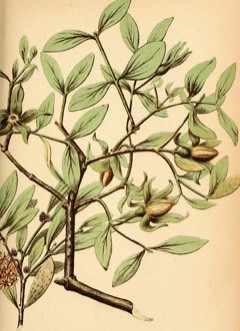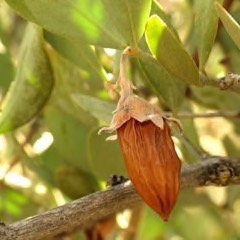 |
|
edibleplants.org |
 |
| Wikimedia.org - Katja Schulz from Washington, D. C., USA |
Translate this page:
Summary
Simmondsia chinensis,
Jojoba is a hardy plant native to arid regions known for its edible nuts. The nuts contain indigestible waxes, tannins, and cyanogenic glycosides, which can cause adverse effects if consumed raw. Raw Jojoba nuts have a flavour similar to Brazil nuts, with a coffee-like bitterness, but they cause vomiting and have a laxative effect due to the wax content, so cooking is recommended. Native Americans used nuts as a food supplement rather than a staple. Cooking neutralises the toxic compounds that are harmful when eaten raw, breaking down the waxes and reducing the bitterness. Despite their potential as a food source, they are more often used in skin and hair care products due to the beneficial oils they contain.
Jojoba is a good soil stabiliser and an ornamental hedge. It requires a period of cooler temperatures, around 15-20°C, to break dormancy and promote flowering. Without this cooling period, jojoba plants will not bloom. Once established, jojoba is highly drought-tolerant and can survive in extremely dry conditions. Its deep taproot can reach depths of up to 25 metres, allowing the plant to access moisture deep in the soil. The plant grows slowly, with male plants typically flowering two years after planting and female plants one year later. Under ideal conditions, jojoba plants can live for over 100 years, though they may remain as small, stunted shrubs in less favourable environments. Jojoba is native to Arizona, California, Mexico (Northeast and Northwest), New Mexico, and Utah.
Harvesting: Late summer to early autumn when the seeds are mature.
Physical Characteristics

 Simmondsia chinensis is an evergreen Shrub growing to 2 m (6ft) by 2 m (6ft) at a slow rate.
Simmondsia chinensis is an evergreen Shrub growing to 2 m (6ft) by 2 m (6ft) at a slow rate.
See above for USDA hardiness. It is hardy to UK zone 10. The species is dioecious (individual flowers are either male or female, but only one sex is to be found on any one plant so both male and female plants must be grown if seed is required). and is pollinated by Wind. The plant is not self-fertile.
It is noted for attracting wildlife.
Suitable for: light (sandy) and medium (loamy) soils and prefers well-drained soil. Suitable pH: mildly acid, neutral and basic (mildly alkaline) soils and can grow in very acid, very alkaline and saline soils.
It cannot grow in the shade. It prefers moist soil and can tolerate drought.
UK Hardiness Map
US Hardiness Map
Synonyms
Buxus chinensis Link
Plant Habitats
Edible Uses
Edible Parts: Seed
Edible Uses:
Seed - raw or cooked. Often parched and then eaten[299 ]. It is also been made into a well-flavoured drink similar to coffee[299 ].
References More on Edible Uses
Medicinal Uses
Plants For A Future can not take any responsibility for any adverse effects from the use of plants. Always seek advice from a professional before using a plant medicinally.
The wax obtained from the seed is applied to the skin in order to alleviate the effects of psoriasis, sores, wounds and other skin afflictions[299 ]. It has been used traditionally as a medicine for cancer, kidney disorders, colds, dysuria, obesity, parturition, aching eyes and warts, and to treat baldness[299 ].
References More on Medicinal Uses
The Bookshop: Edible Plant Books
Our Latest books on Perennial Plants For Food Forests and Permaculture Gardens in paperback or digital formats.

Edible Tropical Plants
Food Forest Plants for Hotter Conditions: 250+ Plants For Tropical Food Forests & Permaculture Gardens.
More

Edible Temperate Plants
Plants for Your Food Forest: 500 Plants for Temperate Food Forests & Permaculture Gardens.
More

More Books
PFAF have eight books available in paperback and digital formats. Browse the shop for more information.
Shop Now
Other Uses
Agroforestry Uses: As a drought-tolerant crop, Jojoba is often used in agroforestry systems. Its deep root system helps prevent soil erosion and improves soil structure. It can also be planted as a windbreak.
It is planted in arid areas to prevent soil erosion[200 ]. The plant makes an attractive clipped hedge[418 ]. Other Uses: A liquid wax is obtained from the seed[299 ]. After ripening and harvesting in the summer, the seeds are crushed and give a liquid wax yield of about 50% by weight[289 ]. This wax, often referred to as jojobe oil, is a unique unsaturated oil composed of non-glyceride esters consisting almost entirely of straight-chain acids and alcohols[299 ]. These compounds are difficult to synthesise commercially and the only other source is the sperm whale[289 ]. The waxes are indigestible, odourless and clear, the processes of isomerisation, hydrogenation and sulphur-chloride treatments produce a range of products from thick creams to crystalline waxes to oils and rubbers[289 ]. Jojoba wax, and especially its sulphur-containing derivatives, are stable at high temperatures, which make them suitable as components of industrial oils, as additives in high pressure and high-temperature lubricants for transformers and gear systems, and as cutting and drawing oils in metal working. The oil or derivatives have potential as a motor fuel. Jojoba methyl-ester fuel runs more quietly than conventional diesel fuel and releases no sulphur. The liquid wax can be converted to a hard wax used, for example, in manufacturing candles. Other applications have been found in the manufacture of linoleum and printing inks[299 ]. The composition of jojoba wax enables it to withstand high temperatures of up to 300°c since it has a flash point of 295°c, a fire point of 338°c, and a low volatility. Jojoba wax has properties similar to the oil secreted by human skin and can be used to lubricate skin and hair for protection against, e.g. ultraviolet radiation. The wax is relatively nontoxic, biodegradable and resistant to rancidity[299 ]. 1. Nectary - Flowers rich in nectar and pollen:
No, Jojoba flowers are not particularly known for being rich in nectar or attracting a wide range of pollinators. However, they do produce small amounts of pollen.
2. Wildlife - Food (Fruit, Seeds, Leaf litter, Shelter, Nesting, Roosting):
Yes – Jojoba seeds are eaten by various wildlife, including small mammals and birds. The plant also provides shelter with its dense branches and leaves, though it may not be ideal for nesting or roosting for larger birds.
3. Invertebrate Shelter (Overwintering sites, Leaf litter, Groundcover):
Yes – Jojoba can offer overwintering sites for insects within its rough stems and leaves. It also provides moderate ground cover in arid or semi-arid environments.
4. Pest Confuser (Smell):
No – Jojoba does not have a strong aroma that confuses or deters pests.
Special Uses
Carbon Farming
References More on Other Uses
Cultivation details
Industrial Crop: Wax Management: Standard New Crop Other Systems: Strip intercrop
A plant of arid regions in the subtropics, it can also be cultivated in arid tropical areas at elevations up to 1,500 metres[299 ]. It grows best in areas where annual daytime temperatures are within the range 21 - 36°c, but can tolerate 10 - 50 with an absolute high of 55°c[299 , 418 ]. Plants require at least one month of lower temperatures, around 15 - 20°c, in order to break dormancy of flower buds - at constantly high temperatures jojoba never flowers[289 ]. When dormant, the plant can survive temperatures down to about -10°c, but young plants are very susceptible to frost damage[299 , 418 ]. It prefers a mean annual rainfall in the range 250 - 800mm, but tolerates 100 - 2,000mm[418 ]. Requires a sunny position in a well-drained light to medium soil[200 ]. Tolerates saline soils[418 ]. Prefers a pH in the range 6.5 - 7.5, tolerating 5 - 8.2[299 ]. Established plants are very drought tolerant[303 ]. Plants are slow-growing[299 ]. In cultivation, male plants may start flowering 2 years after planting and female ones up to 1 year later. Flowering occurs on new growth only and is initiated by low temperatures. Cultivars with different chilling requirements have been selected[299 ]. The plant comes into full bearing in 7 - 8 years, and can bear fruit for 100 - 200 years[418 ]. Flower buds may remain dormant until sufficient moisture is available[299 ]. Prolonged drought may lead to abortion of flower buds and young fruits[299 ]. Under favourable conditions, plants can live for longer than 100 years[289 ]. In more difficult conditions they can survive as small stunted shrubs[289 ]. Plans have a long tap root that is able to penetrate as deep as 25 metres into the soil in search of moisture[289 ]. Thus established plants are very drought tolerant[289 ]. Yields of up to 4.5 tonnes of wax per hectare are believed possible, though in practice 3.5 tonnes is the maximum achieved[289 ]. The plant is dioecious (female and male flowers are found on separate bushes). One male plant for every 5 or so females is required for optimum seed production. Jojoba seeds are typically harvested in late summer to early autumn, usually from September to October (Northern Hemisphere).
Jojoba flowers from late winter to early spring, generally between February and April (Northern Hemisphere), producing small, yellow-green flowers. Jojoba is a slow-growing plant, taking several years to reach maturity, typically about 3 to 5 years before significant seed production occurs. Jojoba is not self-fertile. It requires cross-pollination from male plants to produce seeds.
Carbon Farming
-
Industrial Crop: Wax
Water resistant, malleable substances. Currently, most commercial wax is made from paraffin - a fossil fuel.
-
Management: Standard
Plants grow to their standard height. Harvest fruit, seeds, or other products. Non-Destructive management systems.
-
New Crop
Most new crops were important wild plants until recently, although some are the result of hybridization. They have been developed in the last few, decades. What they have in common is that they are currently cultivated by farmers. Examples include baobab, argan, and buffalo gourd.
-
Other Systems: Strip intercrop
Tree crops grown in rows with alternating annual crops.
References Carbon Farming Information and Carbon Sequestration Information
Temperature Converter
Type a value in the Celsius field to convert the value to Fahrenheit:
Fahrenheit:
The PFAF Bookshop
Plants For A Future have a number of books available in paperback and digital form. Book titles include Edible Plants, Edible Perennials, Edible Trees,Edible Shrubs, Woodland Gardening, and Temperate Food Forest Plants. Our new book is Food Forest Plants For Hotter Conditions (Tropical and Sub-Tropical).
Shop Now
Plant Propagation
Seed - sow in a sunny position in situ or in a nursery seedbed, preferably in slightly alkaline sand or in vermiculite at temperatures of 27 - 38°c[299 ]. After germination, the plant forms a deeply penetrating taproot (which can reach 10 metres or more in mature plants), which can be 60cm long before the emergence of the shoot[299 ]. The seed stores fairly well - germination is good even after 6 months, but viability is reduced to less than 40% after 10 years of seed storage at ambient conditions[299 ]. Cuttings. Propagation by softwood cuttings from selected shrubs that have been treated with IBA can be used. The cuttings are best planted in a nursery under mist. Cuttings take 25 - 40 days to strike root. Fivenode cuttings, taken from actively growing plants, give plants with a strongly growing root system[299 ].
Other Names
If available other names are mentioned here
Goat-nut, Pignut, coffeeberry, quinine plant, wild hazel,pig nut, jojoba, gray box bush, goat nut, deer nut, coffee bush
Native Range
NORTHERN AMERICA: United States (Arizona, California (south)), Mexico (Sonora, Baja California (Norte))
Weed Potential
Right plant wrong place. We are currently updating this section.
Please note that a plant may be invasive in one area but may not in your area so it's worth checking.
None Known
Conservation Status
IUCN Red List of Threatened Plants Status : This taxon has not yet been assessed

Growth: S = slow M = medium F = fast. Soil: L = light (sandy) M = medium H = heavy (clay). pH: A = acid N = neutral B = basic (alkaline). Shade: F = full shade S = semi-shade N = no shade. Moisture: D = dry M = Moist We = wet Wa = water.
Now available:
Food Forest Plants for Mediterranean Conditions
350+ Perennial Plants For Mediterranean and Drier Food Forests and Permaculture Gardens.
[Paperback and eBook]
This is the third in Plants For A Future's series of plant guides for food forests tailored to
specific climate zones. Following volumes on temperate and tropical ecosystems, this book focuses
on species suited to Mediterranean conditions—regions with hot, dry summers and cool, wet winters,
often facing the added challenge of climate change.
Read More
Expert comment
Author
(Link) C.K.Schneid.
Botanical References
Links / References
For a list of references used on this page please go here
A special thanks to Ken Fern for some of the information used on this page.
Readers comment
| Add a comment |
|
If you have important information about this plant that may help other users please add a comment or link below. Only comments or links that are felt to be directly relevant to a plant will be included. If you think a comment/link or information contained on this page is inaccurate or misleading we would welcome your feedback at [email protected]. If you have questions about a plant please use the Forum on this website as we do not have the resources to answer questions ourselves.
* Please note: the comments by website users are not necessarily those held by PFAF and may give misleading or inaccurate information.
To leave a comment please Register or login here All comments need to be approved so will not appear immediately.
|
Subject : Simmondsia chinensis
|
|
|
|